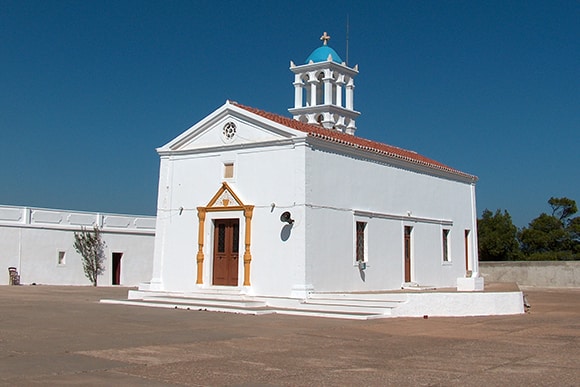
Agia Elesa
The small church of Agia Elesa is located on the steep cliffs, above the village of Livadi, at 433 meters. Saint Elesa’s martyrdom happened in this mountain. Saint Elesa was the daughter of Helladios, a rich lord from the Peloponnese. Her mother was a christian, and she baptized Elesa despite her father’s objections. She raised her in the Christian faith. Her mother died when Elesa was 14 years old. After some time, her father told her he wanted to see her marry any rich lord she liked, promising to leave all his fortune to her. Elesa refused and unable to bear her father’s pressure, she left her home and fled to the island of Kythira on a small boat, where she arrived on the Melidoni coast in 375 AD. Her two adopted daughters chose to follow her. When her father learned where she was, he followed her to Kythira and tried to change her mind and convince her to follow him back home. In vain though, as she proclaimed her faith and devotion to Jesus Christ. Angry he hunted her down trying to kill her. He tortured her, dragged her by the head and hung her from a tree, where he continued beating her, until she collapsed. He untied her and threw her down. Seeming to rise from the dead, Elesa recovered her senses and tried to escape, praying to God. Then the rock she was standing on split open and she managed to flee.
Her father caught her again and decapitated her, on August 1st, 375 AD. Her father left the island taking one of the adopted daughters by force. The other hid and took the remains of the Saint and burried them under the split rock. She returned to the Peloponnese and told all the Christians about the saint’s fateful end. The first Christians who visited her burial site built a small cave temple. According to tradition, after Saint Elesa’s death, worshipers from Mani come to celebrate mass every August 1st.
Today, the temple is of a single-aisle basilica type. It was built in 1871, at the same spot, after the backfilling of the old chapel. The altar was built on top of the grave, on the foundations of the old chapel. At the temple’s entrance, we can see an inscription showing that the temple was built in May, 1871 and paid for by the orthodox Christians. The split ground is visible to this day, while part of it is now a water tank, next to the temple. In the surrounding area of the temple, one can see about 20 cells built in two floors with an abbey and other auxiliary spaces.
Worshippers celebrate the saint’s memory on the 1st of August, a day which coincides with the Dekapentismos holiday. The people of Kythira worship Saint Elesa, who is considered to be the protector of the island and is believed to have tamed the island’s snakes, which are not poisonous anymore.

Leave your comment
You must be logged in to post a comment.